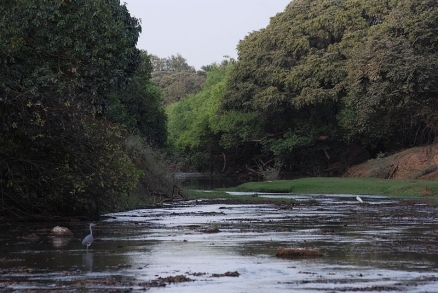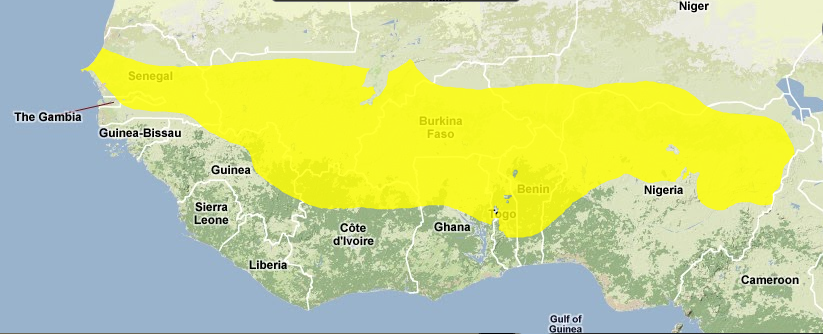West Sudanian savanna
The West Sudanian savanna is a hot, dry, wooded savanna in the Sahel region of North Africa composed chiefly of large tree species and tall elephant grass.
The habitat has been greatly reduced, degraded, and fragmented by agricultural activities, fire, and clearance for wood and charcoal, while populations of most of the larger mammal species have been decimated by over-hunting. Although a number protected areas exist, most are under-resourced paper parks, with little active enforcement on the ground.
The extremely hot climate and poor infrastructure have resulted in relatively little development of tourism in the region.
Location and general description
The West Sudanian Savanna stretches in a band across West Africa south of the Sahel, from Senegal and Gambia to the eastern border of Nigeria. It lies between the Guinean Forest-Savanna Mosaic to the south, and the Sahelian Acacia Savanna to the north.
The ecoregion is mainly flat and lies between 200 and 400 metres (m) in elevation with very few prominent topographical features.
The climate is tropical and strongly seasonal. Mean monthly maximum temperatures vary from 30°C to 33°C and mean minimum temperatures are between 18°C and 21°C. The annual rainfall is as high as 1000 millimeters (mm) in the southern portion, but declines in the north, with only 600 mm found on the border with the Sahelian Acacia savanna ecoregion. Rainfall is highly seasonal: the dry season can last for several months, during which time most trees lose their leaves and the grasses dry up and may also burn.
Geologically, the ecoregion overlies a mixture of Precambrian basement rocks, and a number of post-Jurassic sedimentary basins. To the south of Lake Chad there are deposits dating from the ancient "Mega-Chad", when lake grew to 300,000 to 400,000 square kilometers in area. The soils of the ecoregion are mainly ultisols and alfisols to the south, with entisols found to the north.
The human population density is high over much of the ecoregion. Population densities of 50 to 100 persons per square kilometre are found widely, with up to 300 persons per square kilometre in the region around Kano, Nigeria. Land use varies from permanent agricultural settlements to shifting agriculture and pastoral nomadism.
Vegetation characteristics
White classified this ecoregion within his Sudanian regional center of endemism. The vegetation is mapped as undifferentiated woodland and comprises woody trees (which are mainly deciduous in the dry season, typically Combretum and Terminalia species with some Acacia), and an understory of long grasses, shrubs, and herbs. The principal Hyparrhenia grass species is colloquially known as elephant grass and may be up to three or four metres high. Woodlands include dry communities, normally under 10 m in height, dominated by Anogneissus spp. and accompanied by Acacia spp., Balanites aegyptiaca, Combretum glutinosum, Commiphora africana, Prosopis africana, Tamarindus indica, and Ziziphus mucronata. Elsewhere, wetter woodlands with Afzelia africana, Burkea africana, Combretum spp. and Terminalia spp. grow. The Combretaceae and Leguminosae families are well represented but Acacia spp. are not dominant here as they are in drier woodlands. Finally, to the south, Sudanian Isoberlinia woodland grows. While this has been compared to the miombo woodland of the Zambezian region, it is shorter, with a different and impoverished floristic composition, as well as a more scattered distribution. Small grassy flood plains, or fadamas, are found throughout the ecoregion, with woodland and wooded grassland around the perimeter. Woodland is also found along rivers.
Faunal features
The West Sudanian Savanna possesses relatively few endemic animals, with strictly endemic species restricted to two small mammals (a white-toothed shrew, the Cinderella Shrew (Crocidura cinderella), and the Senegal One-striped Mouse (Lemniscomys linulus), eight reptiles, and three amphibians. Three bird species are considered near-endemic: Long-tailed Cisticola (Cisticola dorsti, DD), White-crowned Robin-chat (Cossypha albicapilla) and Mali Firefinch (Lagonosticta virata). The last of these is mainly associated with the Inner Niger Delta swamps.
Despite the low rates of faunal endemism this is an important area for endemic plants, because it is congruent with part of the Sudanian regional center of endemism. The entire Sudanian area has more than 1000 endemic plants, but the number of plants endemic to this ecoregion is not known. However, the ecoregion is huge, and as a result, the rate of floral endemism per unit area is low.
The pronounced dry season singals a significant migration of fauna within the ecoregion. This includes annual passage of huge numbers of migrant birds on the Afrotropical-Palaearctic flyway, as well as the intra-African migration associated with the seasonal changes in African weather. In the past it also included significant migrations of large mammals, but these have largely ceased due to habitat alteration along the migration routes and the high pressure of hunting which has reduced mammal populations.
There are still a number of large mammal species in the ecoregion, some of which are threatened with extinction. This extinction risk includes a number of West African subspecies of otherwise relatively common large mammal species. A few hundred of the endangered Western subspecies of giant eland (Taurotragus derbianus derbianus) survive in Senegal and Mali, but it has been exterminated by over-hunting in all other countries of its former range, which used to extend to the Niger river in Nigeria. An additional recent threat that emerged in 1999 was the officially sanctioned capture of individuals in Niokola-Koba National Park, Senegal, for transport to a safari park. Small numbers of hunting permits for the species continued to be issued until 1997. Wild dog (Lycaon pictus, EN) persist in small numbers in scattered populations in the savanna woodlands, as do lion (Panthera leo, VU), leopard (Panthera pardus, EN) and cheetah (Acinonyx jubatus, VU). West African populations of elephant (Loxodonta africana, EN) are small, but of great conservation interest for maintaining the ecotourism potential of the protected areas. So too are the remnant populations of the Western giraffe (Giraffa camelopardalis peralta), numbering less than 100 animals in Niger and Mali. Roan antelope (Hippotragus equinus) and West African savanna buffalo (Syncerus caffer brachyceros) are also mostly restricted to protected areas in this ecoregion.
There are several restricted range reptiles occurring in the upper reach, including Armitage's Cylindrical Skink (Chalcides armitagei), which is endemic to the West Sudanian savanna and also ranges somewhat to the south of the Senegal River basin into Gambia and Guinea Bissau. The Guinea Fringe-fingered Lizard (Acanthodactylus guineensis) is also endemic to the West Sudanian savanna and is found chiefly in the mouth area of the Niger River and the upper reaches of the Senegal Basin. Joger's Saw-scaled Viper (Echis jogeri) is an endemic snake to the West Sudanian savanna that occurs in the upper portion of the Senegal River Basin. Thierry's Cylindrical Skink (Chalcides thierryi) is also endemic to the ecoregion and is found in the upper Senegal River Basin. The White-bellied Worm Snake (Myriopholis albiventer) is another endemic of the West Sudanian savanna found in the upper Senegal Basin. The racer Coluber dorri is also found in the upper reach of the Senegal River Basin, but may also occur in lower reaches; this taxon is another endemic to the West Sudanian savanna ecoregion.
Amphibians endemic to the West Sudanian savanna include the Pale Running Frog (Kassina fusca), an anuran occurring in the upper reach of the Senegal River Basin and extending eastward at least as far as the Niger River Basin; the Mali Screeching Frog (Arthroleptis milletihorsini), endemic to the West Sudanian savanna and found in the upper Senegal Basin; and Amietophrynus chudeaui, an anuran known only to Bata Marsh in Nioro Cercle, Mali.
Ecoregion status
There has been significant loss and fragmentation of the original wooded savanna habitat, especially in areas of high human population density such as Nigeria. The remaining blocks of habitat are found mainly in protected areas, which have been established in most of the countries of the ecoregion.
The total area of protected lands is over 90,000 km2. This is a relatively large area, but only represents 6.7% of this huge ecoregion. There are also damaging activities occurring in many of these protected sites, which are resulting in further declines in large animal populations. Protected areas in this ecoregion include the Boucle du Baoulé National Park in Mali, the River Gambia National Park in Gambia, Niokolo-Koba National Park in Senegal, Kainji Lake National Park in Nigeria, Mole National Park in Ghana, and Comoe National Park in Côte d’Ivoire, as well as the transboundary ‘W’ National Parks in Niger, Burkina Faso, and Benin.
Types and severity of threats
The habitats of the ecoregion are principally threatened by the agricultural and herding activities of the local populations. There are considerable pressures on the land from seasonal farming, grazing animals, cutting trees and bushes for wood, burning woody material for charcoal, and from wild fires. All of these pressures have reduced and degraded natural habitats. Climatic desiccation is a further threat, exacerbating human pressures, as the ability of the ecosystem to recover from overuse is reduced when there is little rainfall.
The main threats to the animal species of the ecoregion come from human use of the habitat and especially from hunting. For the larger mammals, hunting for food and for sport has removed many species over wide areas; species such as giraffe, wild dog, lion, and elephant are now much reduced (some to single viable populations). The black rhinoceros (Diceros bicornis) was extirpated decades ago. Even within protected areas, commercial and subsistence poaching is rife, and illegal grazing of livestock occurs extensively.
A particular threat to the migratory wildlife (especially birds) is the drainage and pollution of wetlands. Large-scale agricultural initiatives, dams, and river diversion schemes are proposed, and in some cases have been completed. These can change or reduce flood regimes of inland wetlands, which are generally seasonal and dependent on rainfall. In Nigeria, in particular, some of the agricultural schemes have damaged these wetlands, with potential negative consequences for the wildlife and the people's whose livelihoods depend on fishing or seasonal farming related to the floods.
Justification of ecoregion delineation
This ecoregion, along with the East Sudanian Savanna, forms part of the Sudanian regional center of endemism, and contains two vegetation units, the ‘Sudanian undifferentiated woodland’ and ‘Sudanian woodland with abundant Isoberlina’. Although these two units differ in the presence of Isoberlina, with the northern unit being slightly drier, they share similar animal assemblages. The West and East Sudanian Savannas have been separated at the Mandara Plateau, which forms part of the chain of high elevation areas that separate West and Central Africa, and is a boundary for several plant taxa.
Further reading
- Happold, D.C.D. 1987. The mammals of Nigeria. Oxford University Press, Oxford. ISBN: 0198575653
- Hogan, C. Michael, 2014. Amietophrynus chudeaui. African Amphibians. ed. Breda Zimkus
- Hollis, G.E., W.M. Adams, and M. Aminu-Kano. 1993. The Hadejia-Nguru Wetlands: environment, economy and sustainable development. IUCN, Gland and Switzerland.
- East, R. compiler. 1999. African Antelope Database 1998. IUCN/SSC Antelope Specialist Group. IUCN, Gland, Switzerland and Cambridge, United Kingdom. ISBN: 2831704774
- East, R. 2000. Antelope captures in Niokola-Koba National Park, Senegal. Gnusletter, 19(2): 4-6.
- Udvardy, M. D. F. 1975. A classification of the biogeographical provinces of the world. IUCN Occassional Paper No 18.
- White, F. 1983. The vegetation of Africa, a descriptive memoir to accompany the UNESCO/AETFAT/UNSO Vegetation Map of Africa (3 Plates, Northwestern Africa, Northeastern Africa, and Southern Africa, 1:5,000,000). UNESCO, Paris. ISBN: 9231019554
- WWF. 1998. A conservation assessment of terrestrial ecoregions of Africa: Draft proceedings of a workshop, Cape Town, South Africa, August 1998. World Wildlife Fund, Washington, DC, USA.
| Disclaimer: This article contains information that was originally published by the World Wildlife Fund. Topic editors and authors for the Encyclopedia of Earth have edited its content and added new information. The use of information from the World Wildlife Fund should not be construed as support for or endorsement by that organization for any new information added by EoE personnel, or for any editing of the original content. |

%2c_Ghana.jpg)

%2c_Senegal.jpg)